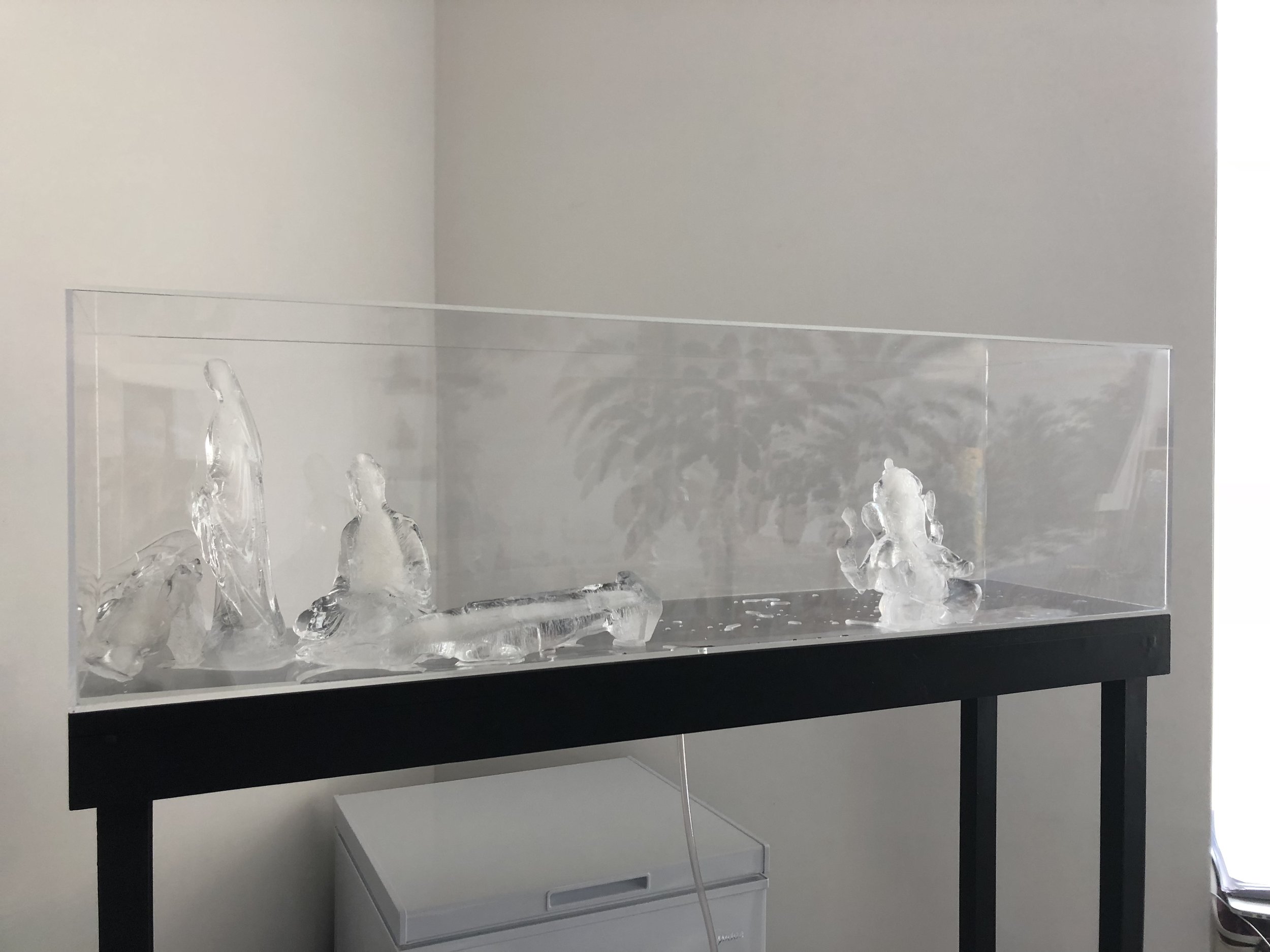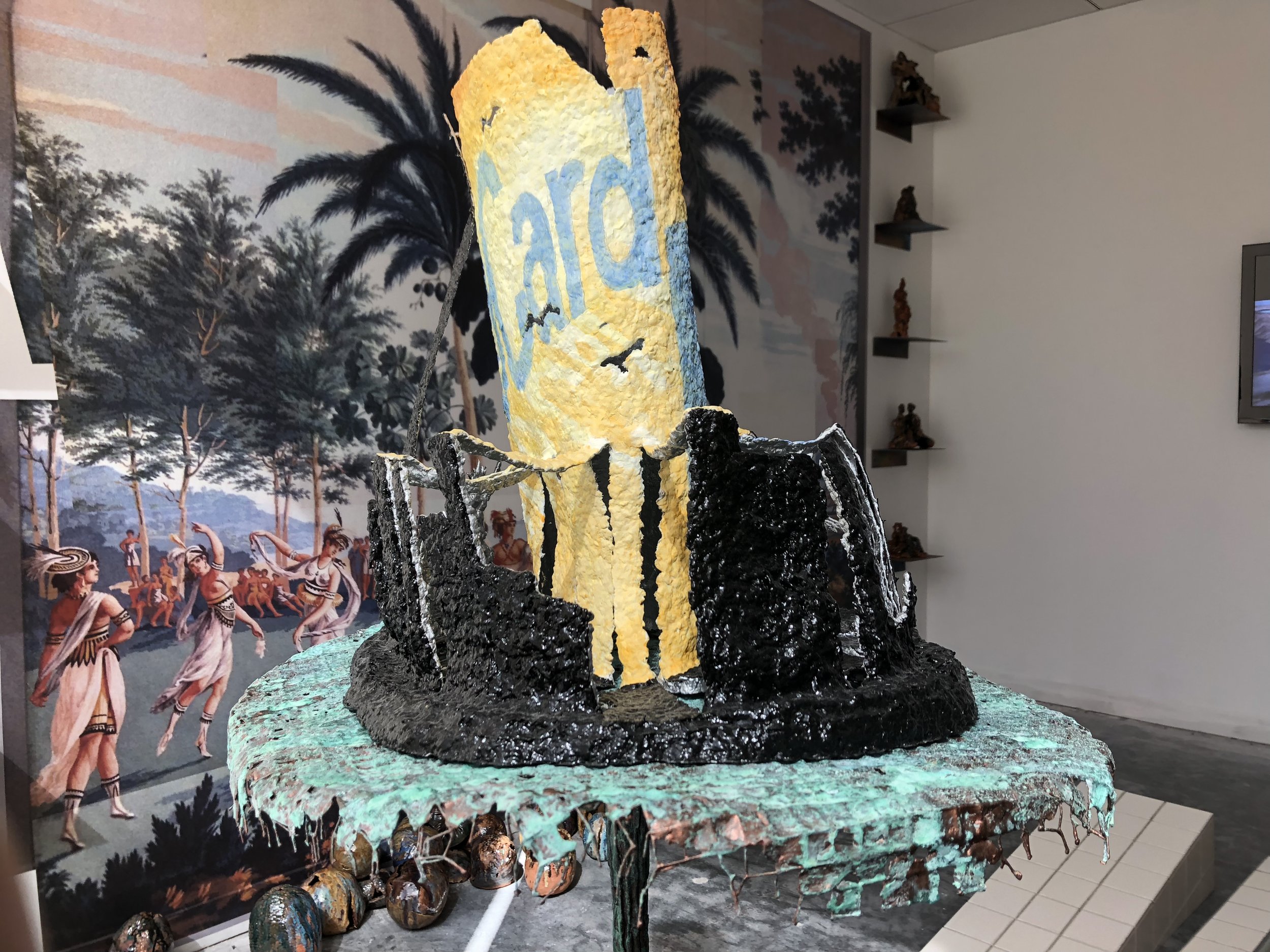SUPERHEATED IS AN EXHIBITION AT SPRING//BREAK ART FAIR 2018, NEW YORK, NY, CO-CURATED BY MYSELF AND RACHELLE DANG
(L-R) Elizabeth Englander, Rachelle Dang, Zac Hacmon and Eleanor King
Kyoko Hamaguchi
(L-R) Kyoko Hamaguchi, Elizabeth Englander and Rachelle Dang
(L-R) Jessica Mensch and Kyoko Hamaguchi
(L-R) Rachelle Dang, Zac Hacmon and Eleanor King
(L-R) Elizabeth Englander and Rachelle Dang
SUPERHEATED looks at strange and overheated encounters – from the arctic to the tropics, from the past to the future to late last night. Through video, sculpture, photography, and installation, the six artists of SUPERHEATED foreground questions of otherness at the site of the seemingly familiar, revealing the fictional, historical, ideological, and illusory at play in every entanglement.
Artists:
ELEANOR KING
In the video “Pang,” Eleanor King uses Google Earth to remotely visit the landscape of her former home – the Arctic village of Pangnirtung, Nunavut, Canada. King questions how the surveillance capabilities of satellite imaging and the Internet have altered notions of the familiar. “Pang” traverses a glitchy landscape, soaring above like a cyber-pilot or hovering close to the water’s edge, tempting us to believe in the illusion of infinite vision. In the soundtrack, King combines field recordings of iceberg "calving" incidents with her own musical compositions to produce an affective and disturbing meditation on the melting of sea ice in the age of Late Capitalism. The unfamiliar and familiar, the real and the simulated exist within one time/space of “Pang,” disrupting any sense of stability or safe haven. www.eleanorking.com
JESSICA MENSCH
Jessica Mensch's videos suggest a superheated, dreamlike world created from fragmented tropes of mythology, B-movies, and experimental film and theater. Born in New Mexico and based in Montreal and New York, her work plays on reality, non-reality, and illusion with hand-made, analog excess. Through lighting and set design, absurd props, physical comedy, and abstract soundscapes, Mensch transforms the familiar into something strangely fantastic: what we think we know loses all credibility. In “Bio Caprice,” Mensch spectacularizes the genre of animal television as homemade sci-fi docudrama by fast-forwarding it into a dystopic future, where aliens tune-in to watch Earth’s last animal survivors inhabit a smoldering, vaporous new world. Mensch deconstructs our almost creepy obsession with turning the natural world into a mirror of our own – emotionally, psychologically, and domestically – with humanesque animals strangely embodying our own fears and desires. www.jessicamensch.com
ELIZABETH ENGLANDER
With “Staten Sunrise,” New York-based artist Elizabeth Englander takes the familiar yellow sunrise of the NYC Subway “MetroCard” as the jumping off point for a sculpture that comments on pleasure, adventure, and the intoxicating lure of the unknown and the grotesque. The larger-than-life embodiment of the MetroCard functions in Englander’s work like a strange beacon sinking with the rest of Manhattan into the Hudson’s coppery sludge. At the foot of the sculpture, two figures grab hold of each other, locked in a backwards embrace: lovers or strangers sweeping themselves up after a long night, holding city and sky between them.
www.kimberly-klark.com/elizabeth-englander
KYOKO HAMAGUCHI
The work of Kyoko Hamaguchi (b. Tokyo, Japan) inhabits the in-between space of the representation of an image and its abstraction. “God of the Day” conveys the material merging of difference: inside a glass vitrine, ice-cast (Virgin Mary, Buddha, Anubis, Ares and Ganesha) melt and become one over the course of a day, their elemental and ideological transformation collected into a single bottle. At the daily closing of the exhibit, the water collected is poured back into their respective molds and refrozen; erasure of difference is expressed through the melting of the figures and there subsequent transformation into abstract forms. www.kyokohamaguchi.com
RACHELLE DANG
In “Vessel (Les Sauvages de la mer Pacifique, 1806),” Rachelle Dang (b. Honolulu, Hawaii) plays both sides of the beach, willfully reconstructing, dismantling, and corrupting the colonial image of the foreign, exotic Other. She examines how imperial knowledge – such as French ethnographic imagery repackaged as domestic wallpaper – was used as a vehicle to bestow “right to power.” Her hand-built ceramic figures function as a counter-aesthetic: they are distressed and disfigured versions of what one sees in the wallpaper. They disrupt the aesthetic harmony and unity of the image, challenging romantic aesthetics which cloak an ideological political program. Inside this critical navigational space, the artifact of empire has shed its skin and its command; its fabrication and power now deteriorated, suspect, disturbing, and strange. www.rachelledang.com
ZAC HACMON
Zac Hacmon’s sculptures deal with the relationship between architecture and the human body to examine notions of home/no-home, displacement, and conflict. Hacmon uses familiar materials such as industrial tiles, but not for their intended function; the fakeness of material usage addresses ideas of concealment and desires for a false belonging to home or nation. Tiles are a cultural signifier in Hacmon’s New York surroundings and also in Tel Aviv, Israel, where he grew up amongst Bauhaus and Modernist architecture, and saw the demolition of older Eastern-Western hybrid buildings. His sculptures talk about history, collective memory, and the invasion of authority and power. Materials and forms otherwise symbolizing safety and belonging reemerge fractured and destabilized.
www.zachacmon.com
Curators:
Jessica Mensch and Rachelle Dang are New York-based mixed-media artists and curators currently in the MFA program at Hunter College. Jessica Mensch obtained her BFA in Painting from NSCAD in 2006, and has since exhibited at SPRING/BREAK in 2014, 2016, and 2017, at The Confederation Centre in PEI, The National Gallery of Canada, Art Toronto, Superchief Gallery (NY) and Pop Up Gallery PS1 MoMA (NY). Mensch was the recipient of a Canada Council Grant for Visual Arts in 2014, and a finalist for the RBC Painting Prize in 2013. She forms half of the collaborative group, Inflatable Deities, with Emily Pelstring. Rachelle Dang is a graduate of Wellesley College and a recent artist-in-residence at MASS MoCA. Her work has been exhibited at the Honolulu Museum of Art, Hawaii Pacific University, the Korean Cultural Center in Los Angeles, TAG Gallery in Santa Monica, and in New York at the Brooklyn Academy of Music, Sarah Lawrence College, and Sleep Center. Mensch and Dang began their collaborative curatorial initiative in 2017.
PRESS:
Hyperallergic: "Spring Break is an Oasis for Art Fair Haters", by Hrag Vartanian, March 7, 2018
Artnews: "A Tour of the 2018 Spring/Break Art Show", by Maximiliano Duron, March 7, 2018
Bedford & Bowery: "The Best of Spring/Break, the Outre Art Fair in an Abandoned Times Square Office Building", by Scott Lynch, March 7, 2018
Droste Effect: "Armory Week: Independent, SPRING/BREAK and NADA", March 9, 2018
ARTFORUM: NEWS “Spring/Break Art Show announces seventh edition venue and curators”, February 8, 2018





